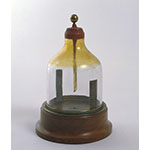Gold-leaf electroscope. The instrument, invented in 1786 by Abraham Bennet, consists of an upright brass rod whose lower end holds two very thin gold-leaf strips and whose upper end is fitted with a ball. A glass bell-jar encloses the lower part of the rod and the gold-leaf strips, preventing them from being moved by air currents.
When the conductor is not charged, the strips will align vertically because of gravity. When, instead, the ball is touched by an electrically charged body, part of the charge is diffused throughout the conductor. The strips become identically charged and repel each other, forming an angle proportional to the charge. The phenomenon is based on one of the fundamental properties of electrostatics: bodies with electrical charges of the same sign repel each other, while those with opposite electrical charges attract each other. The two tin-foil strips at opposite sides of the dome will leak the excess charge to ground. Provenance: Lorraine collections.










